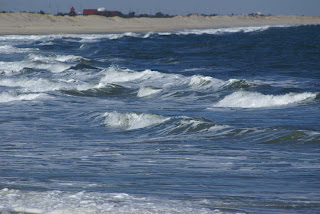Everything—color, shape, lighting—is different. The sand, lacking the sun’s summer heat to bake out the moisture, goes from that neutral beige favored by home decorators to a cold gray. Footprints last days, even weeks in the damp and pockets of frost and sea ice linger in the hollows. This would be a great time to build magnificent sand castles if you could keep any feeling in your fingers. The major change to the winter beach is the cold. A damp chill that penetrates the marrow of your bones, combined with the constant wind straight from the Pole, stings then numbs any exposed skin. You are at the lowest part of the continent and the cold runs downhill like water. Bundle up.

Thin winter light and sharp shadows give a painterly cast to the landscape, while the sea itself is a deeper, darker color. Waves, depending on the recent weather, either hiss up the slope in slides of foam and ice, or drop all at once like a collapsing wall. Surfers are few and far between. The beach shape turns from a long easy glide to the water’s edge into a double slope with a three-foot berm separating the upper beach from the lower. Skeletons of shipwrecks, keel and ribs poke out the sand on the upper beach. When the wind is right and nobody else is about to distract you, snatches of voices, just below hearing threshold, go through your brain. Old beach combers say certain beaches are haunted; maybe so.


Birding winter beaches has its points. While the number of familiar species is down, no pelicans, terns, or laughing gulls, the beach holds surprises. Razorbills, murres, and loons, birds of the Arctic, sport in the wave troughs, while rafts of snow geese newly arrived from Greenland bob just outside the breakers.

A few familiar birds eke out winter sustenance along the tide line. Herring gulls, some possibly remembering summer handouts, sidle up like hopeful beggars or stand wrapped in their feathers, one baleful eye following you. Sanderlings, birds who spent their summer in the high Arctic, are here all year, running like windup toys along the edge of the sea foam. A circumpolar species, they are probably the best traveled bird on the planet. Sanderlings spread out on winter beaches from Cape Cod to Tierra del Fuego on the Atlantic and from Korea to Australia on the Pacific.

I have been visiting winter beaches all my adult life. I always find something new, something different. A plethora of purple starfish along the top of the lower beach, cast up by last night’s high tide, gone the next day and replaced by an equal number of moon snail shells. Sometimes, purely by chance if you happen to be looking out to sea at the right time, the flukes of a sounding whale, probably a humpback. And once, a young harbor seal, with heart shaped nose and soulful puppy dog eyes, perched on a rock at the jetty. Fins tucked in, dozing in the watery light, waiting for the tide to turn and fish to catch.
